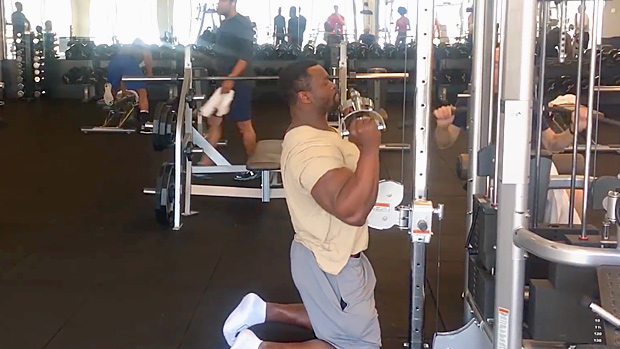In the first part of our interview, Alwyn Cosgrove — coach, gym owner, entrepreneur, and two-time cancer survivor — expounded on the business of fitness, and why it takes more than a love of working out to succeed as a personal trainer.
Now, in part two, Alwyn tackles the difficult issues of getting clients to comply with a trainer's programs, enticing new members to a no-frills gym, and how to know if you're cut out for a career in the fitness industry.
Testosterone Muscle: Let's talk a little bit about managing your clients. How do you keep a client compliant outside of the gym? How do you know they aren't going home and eating crap all day, all but nullifying the work you do with them in the gym and making your training look ineffective?
Alwyn Cosgrove: If a client isn't compliant, it's because you haven't educated them on the importance of what you're giving them, and they don't believe you. Or, your advice sucks.
Let's say you've got a 40-year-old guy who's never worked out before. He eats one meal in the morning, and it's pancakes. And then his next meal is dinner and he has a couple of beers. And you're like, "No, eat five egg whites and steamed broccoli for your breakfast, and asparagus and a grilled chicken breast for your mid-morning snack!"
He's not going to follow that. It's too much of a change. You have to meet him where he's at. You have to have compliance to know if the plan works, or if he's messing it up by not following it. Without that compliance, it's just guesswork.
My first diet for that guy might be to reduce the size of the pancakes, add some eggs, have a shake mid-morning, maybe a Subway sandwich for lunch, a shake in the afternoon, and cut back on his dinner. He'll make progress with that.
Now if you saw that diet, you'd think, man, that's shitty advice! But this is step one. I'm getting compliance with him. It doesn't matter what the plan is yet. It just has to be something he'll follow.
One of our rules is that you have to follow this plan 90%. Now, the plan has 35 meals a week. For three of them, you can have whatever you want. But if you don't follow it for the other 32, it's not going to work.
In other words, would you rather have a harder diet and more cheats, or would you rather have an easier diet and less cheats? That's how I negotiate it. Meet them where they're at, and make baby steps along the way.


The power of compliance: This Cosgrove client, at 40 years old, lost 80 pounds and gained a six-pack.
TM: So if the client is drinking six full-sugar Dr. Peppers a day and messing up his results ...
AC: Sixteen weeks from now, I want no Dr. Peppers. That's the goal. But that doesn't mean tomorrow he's going cold turkey. Maybe I get him to cut down to four a day the first week.
TM: How else do you keep clients on target?
AC: We measure every week. They also have to keep a food log. At worst, they have to keep a compliance grid showing when they were compliant or not. If I look at the food log and I don't get 90%, I don't measure because the client is wasting his time and mine.
But if a client is eating whatever he wants and just loving what you're doing for him, he may not be dropping body fat. But if he's feeling better, his back that used to hurt no longer hurts, and he loves working with you, then you can't get upset just because you don't have a before and after picture.
People hire trainers for three reasons: to look better, feel better, or perform better. You maybe don't know what he's there for. He may be there just to improve his golf game. You improve that, and maybe he doesn't care about his abs.
TM: Tell us a little about your business model.
AC: One of the things we've always said is that the fitness industry can deliver good results, fast results, or a cheap service. Good, fast, or cheap — you can pick any two you want.
So I can get you good results fast, but it's not going to be cheap. I can get you fast results cheap, but they won't be good. And I can get you good results for cheap, but that's going to take a long time.
Our business model is based on good and fast.
TM: Tim Patterson and I talked recently, and he said that people will invest in themselves in a bad economy, and cut back in other areas instead. What have you seen regarding a tough economy and the fitness biz?
AC: I would agree 100% with Tim. We haven't seen any dropoff at all. I think people have seen the value associated with our services. They'll cut back cable TV, or they'll cut dinner out once a week, but they're not going to cut back on their health and fitness.
There's a saying in marketing that everyone has a third place. You have home, work, and one more place you go. Maybe it's a bar or a coffee shop, or maybe it's the gym. They won't give up their job, their house, or their third place. You can become that third place for people.
If you're a trainer and someone decides to no longer use your services, no matter what they tell you, it's not about the money. It's the value attached to the money. They've decided you're no longer worth it. That's the bottom line. You're no longer worth the dollar figure. It's not that they can no longer afford that dollar figure. It's just going elsewhere.
TM: What trends are you seeing in the training business?
AC: I think one-on-one training is largely dead. I think you need to be moving in a semi-private direction, and you need to work more as a consultant, where you design programs for people. Instead of supervising every workout, you meet them once a week or once a month.
TM: Really? Do you see that happening in regular gyms, or just with established coaches like yourself?
AC: Most personal trainers do one-on-one only. Why? They can't answer why. It's just the way it's always been done. But just about everything else in life, from getting chemotherapy to coaching professional sports, is done in groups.
With semi-private, where you see three people at once, you're at leisure to lower your buyer entry. You can make more money for the same time. It's harder work, but you can make more income. The gym can make a bigger percentage, while the client pays less. It's a win-win.
The other way to do that is, instead of charging $50 a training session, maybe you charge $100 for program design plus one training session, and then that client checks back in with you in a month. Now your hourly rate just went up. The client only spends $100 a month on a trainer instead of spending $50 dollars each workout.
You have to get more clients to make ends meet, but it allows you to tap into a different service offering.
TM: A lot of people out there think they'd make good trainers and coaches, but when I hear the advice they give, or see it on forums, I wonder how they could ever make a living in this business. In your experience, is there a type of person who shouldn't go into training or coaching?
AC: I read a question on a forum once from a 19-year-old kid. He wanted to be 200 pounds lean, but he was a pudgy 185 at the time. He asked about losing some fat first because he had a horrible family history of health problems — dad died of a heart attack at a young age, mother had problems, etc.
The advice he got was to get to 240 pounds before he even thought about losing fat. I was like, did you read the medical history there? So yes, some forum vets would make very poor trainers.
The problem with the advice was the advice givers' inability to look outside of themselves. If you can't look outside of yourself and see other goals and other situations, you're never going to succeed as a trainer. So we're back to having some sort of empathy and being able to understand the client's mindset.
Again, being a trainer has nothing to do with how much you like to do incline dumbbell presses. It has to do with wanting to help people. Some people in the gym are doing the right thing, and their bodies aren't changing. They're not all just lazy. A lot of them are just getting bad advice.
You have to be able to see that it's not about you. If you wear a cut-off tank top while training someone, you probably aren't perfect for this deal. You're really more interested in how you look, instead of focusing on your client.
I've had trainers come up to me and say, "I know more than this other trainer and yet he has more clients than me." I say, "Well, maybe it's because you're an asshole and no one wants to hang around with you."

TM: Makes sense. Who wants to spend three hours a week with someone they can't stand to be around, and pay for the privilege?
AC: I've always said to trainers, if you have a client who makes you miserable, fire him. Don't make yourself miserable by having that type of client around. But on the flip side, make sure that you aren't that type of asshole.
TM: How important is it to look the part for your client? It seems to me that it cuts both ways. An overweight personal trainer might not get much business from those seeking fat loss. But at the same time, I know some steroid-using bodybuilder types who can't get business because their potential clients don't want to look like that.
AC: You have to look professional. That's the phrase I prefer. I wouldn't hire a lawyer who's wearing a Beavis and Butthead T-shirt and cutoff jeans, and I'm not going to hire a trainer who doesn't look professional.
How does he dress? Is he smelly? Does he have a baseball cap on backwards? That's for working out. That's not being a professional.
But there's another side to this. I've been an athlete. I've also been the guy who's just had chemotherapy. I looked like an athlete one time, and a cancer patient the other time. But here's the thing: I knew a lot more about training when I was the cancer patient.
So maybe you see a personal trainer with 75 pounds to lose. You need to ask, how much has he lost already? Maybe he's lost 100 pounds so far, and he knows more about fat loss than any of us.
Then again, if he's been 75 pounds overweight for three years, he probably doesn't know what he's doing!
TM: What about being "too big" as a trainer?
AC: If you're a professional bodybuilder, then you're genetically gifted enough to make a living from your body, right? Well, you're absolutely of no use to me whatsoever because I don't have those genetics. I'm more interested in hearing from a regular guy who's made an amazing transformation. As someone who's been out of shape, that guy knows what a client feels like.
I was at a seminar with a competitive bodybuilder who got up at 4:30 in the morning to do 90 minutes of cardio. Carried a gallon and a half of water with him everywhere he went, and brought all his meals for the weekend in Tupperware. He actually brought a microwave oven with him to make sure he could prepare his meals in his room.
If that describes any client that you've ever had, then that guy can teach you something. But he's got those genetic gifts, discipline beyond imagination, and is probably on drugs. That guy has absolutely zero relevance to helping a 40-year-old woman lose 10 pounds.
Getting back to the appearance of trainers, my basic rule is that they should look like they exercise. They don't have to look like a cover model, but they should look like they can do a few chin-ups.
TM: I've always respected your advice, Alwyn, because you work with athletes and regular people. I worry there may be a "strength coach bias" out there, meaning that if you work with elite professionals and Olympians all day long, then maybe you forget about how to get results with people with average genetics and jobs and stuff.
AC: I think that's a fair point. I think if you're being exposed to genetically gifted, full-time athletes, your methods are a little different. It's not that you're lying or you're wrong, you just have a different demographic.
I remember talking about fat loss with Mike Boyle once. Now, Mike has trained some of the greatest female athletes in American sport. He's trained Olympians and tons of hockey players. Anyway, I said that I hadn't seen aerobics really pan out for fat loss. Mike said that his athletes just add an extra 45 minutes on the bike when they need to lose fat.
I'm like, Mike, those guys have a two-hour practice every day and two hours with you. If they're still fat, you're going into the fifth hour of exercise that day [by adding aerobics]. But when you've only got three hours per week with a client, not four-plus hours a day, that tool becomes useless.
One of the reasons I don't use split routines is I don't think having someone train a body part once a week makes any sense when I only get three workouts with them. If I had somebody who trained five or six days a week, that starts to open up more options.
But I start with the client who doesn't exercise very often, is likely to miss workouts, and can only give me three to four hours a week total. I design programs around that.
I hear interesting training protocols all the time, like "take 20 branched-chain amino acid pills after your 4th, 8th, and 12th sets." Yeah, try that with an ordinary person! I'm sure this isn't incorrect advice, but it isn't relevant to the average client.
TM: You're a real trainer working with real people in the real world. That cuts through the bullshit and theorizing pretty fast, because results are your business. No results, no mortgage payment, right?
AC: If I don't get these people in shape, they go elsewhere, and I don't get paid. That's it. The athletes I train pay out of their own pocket. If they come and they don't see a result, they don't come back.
I get results better and faster than anybody else I know. If someone else got results faster than I did, I would copy them. I don't have a religious attachment to my ideas. I'd steal their ideas. I'd have to be an idiot to not evolve my training over time.
If somebody is getting better results with their clients than you, and making more money than you, it's not your fault that you're not as good as him. You haven't been taught what he knows. You don't need to figure it out on your own. Just copy the person who's doing it better!
Hey, how many milligrams of EPA/DHA do you need on a regular basis to prevent inflammation in the body? Well, you can figure that out, or you can just take Flameout, right? Somebody else has already studied this shit and come up with the answer!
Eliminate your ego and be open to what works. I don't care what you like. The only thing that matters is the result. It doesn't matter what the sign says, what the magazines say, what you think should happen. What actually happens is the only important thing.
TM: There might be a million business books written about networking. But how important is it to a fitness professional?
AC: Your network may determine your net worth. I need to find people better than me in certain areas, and learn from them or refer people to them.
Now, those bullshit breakfast meetings with other businesses that have absolutely nothing in common with yours, or talking on a forum with the same group of people, neither of those is networking. That's hanging out.
We have a great PT guy in our area. I don't need to understand how to rehabilitate soft-tissue injuries. I just refer to him. And it goes both ways. He doesn't need to know how to get people in shape. He just refers them to me. That's networking.
I like to network by going to seminars and hiring people for things. People treat you a whole lot different when you're a paying customer. My goal is to be the dumbest person in the room as much as possible, to surround myself with people smarter than me.
The turning point in my career was when I decided there were trainers who were better than me, so I started following them around and asking them questions, and copying what they were doing. I took at least two guys to lunch every week, and just hammered them with questions. I bought one book on training every week with one session's worth of money. That's 52 books a year — a lot of information.
I started hiring other coaches, going to seminars, hiring business coaches. In a way, that was networking, and I still do it. I had a structured approach, an objective, every time that I met these people. I didn't just want to hang out.
I was investing in my own education. You don't go to school once in your life. You go to school every day of your life.
TM: I have to ask you an odd question: What's up with the Planet Fitness gym chain? The "no grunting" signs, the "lunk alarms" that go off when someone starts to act a little too hardcore. Some are even removing the heavier weights. What exactly is going on there?

AC: I have no idea, other than they're trying to position the market so they don't attract the serious fitness enthusiast. It seems odd that there's a market for not-serious fitness, right?
I completely disagree with their philosophy. Everybody deadlifts in my gym. And pretty much everybody grunts at some point.

So I'm always aware that Planet Fitness is not for me, just like Curves is not for me. But what are they doing right? Why is Planet Fitness making money? Because it's established exactly who it's for. Curves has established who it's for.
I don't really like coffee, so I don't go to Starbucks. But Starbucks has established exactly what they do. You don't go to Starbucks to get a protein shake, right?
When gyms start eliminating load over an arbitrary number, and eliminating exercises because they don't want to associate with bodybuilders, they're selling a membership to a club. They're definitely not selling fitness, and there's no way they're selling results.
A good trainer can get somebody in shape no matter what equipment is there. But you would like to be able to lift something off the floor occasionally, and maybe use dumbbells over 45 pounds!
TM: I have a theory that the big gyms fill their floors with shiny machines to attract new members. They're decorations. I never see half the machines in my gym being used, but I have to think they're appealing to someone who's never done a serious training program.
AC: We have no machines at all, but it would be a much easier sale if I had a whole bunch of shiny new things. When people come into my gym and they see kettlebells and open space and platforms and a chinning rack, it's not the sexiest sale in the world.

Everyone deadlifts at Alwyn's gym.
TM: Yeah, you can just wave your hand and go, "There's the gym. Tour over."
AC: I've seen people at commercial gyms who're like, "Hey, you said something about how you want to tone up your inner thighs. Jump on this machine!" And they put the potential member on the inner-thigh machine, and the lady says, "Wow, this is the place for me! I need this machine!"
That's the bullshit stuff I don't like. No one has gotten in shape on the inner-thigh machine.
TM: To wrap it up, is there anything you want to say to all the people reading this who're thinking of a career in the fitness biz?
AC: You know how waiters in California restaurants all used to be out-of-work actors? Well, today they're personal trainers. And I hate that. I hate being associated with that.
If you're one of those guys, just get out, man. Don't dabble in this. It's hard enough for me, and I've spent a lot of time studying it. If you think you get it because you've read some fitness magazines and you have 25,000 posts on a forum, you don't. Just get out. Go and do something else. I'll give you a job cleaning up my gym.
On the other hand, if you're serious about it, become a professional, raise your standards, and continually invest in yourself.
TM: Alwyn, thanks for the interview!
The LiftStrong CD is available here. All proceeds go to the Leukemia and Lymphoma Society.
Alwyn's new book, 55 Fitness Business Strategies for Success, is available here.






